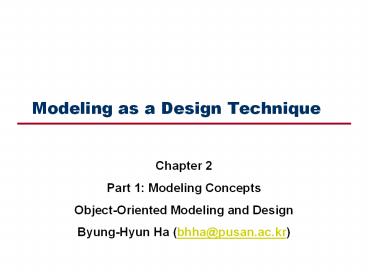Modeling as a Design Technique PowerPoint PPT Presentation
1 / 8
Title: Modeling as a Design Technique
1
Modeling as a Design Technique
- Chapter 2
- Part 1 Modeling Concepts
- Object-Oriented Modeling and Design
- Byung-Hyun Ha (bhha_at_pusan.ac.kr)
2
Lecture Outline
- Organization of the Textbook
- Introduction
- Modeling
- Object Modeling Technique
3
Organization of the Textbook
- Part 1 modeling concepts
- Object/dynamic/functional modeling
- Part 2 design methodology
- Analysis, system design, object design
- Comparison of methodologies
- Part 3 implementation
- From design to implementation
- Programming style
- Object-oriented languages and non-OO languages
- Relational databases
- Part 4 Applications
4
Introduction
- Abstraction
- Fundamental human capability that permits us to
deal with complexity - Selective examination of certain aspect of
problem - Abstraction must always be for some purpose,
because the purpose determines what is and is not
important - All abstractions are incomplete and inaccurate.
Reality is seamless web. Anything we say about
it, and description of it, is an abridgement. All
human words and language are abstractionsincomple
te descriptions of the real world. - This does not destroy their usefulness. The
purpose of an abstraction is to limit the
universe so we can do things. - In building models, therefore you must not search
for absolute truth but for adequacy for some
purpose. There is no single correct model of a
situation, only adequate and inadequate ones.
5
Introduction
- A model
- An abstraction of something for the purpose of
understanding it before building it - Easier to manipulate than the original entity,
because a model omits nonessential details - Engineers, artists, and craftsman have built
models for thousand of years to try out designs
before executing them - To build complex system
- Developer must abstract different views of the
systems, build models using precise notations,
verify that the models satisfy the requirements
of the system, and gradually add detail to
transform the model into an implementation.
6
Modeling
- Purposes
- Testing a physical entity before building it
- Communication with customers
- Visualization
- Reduction of complexity
- A good model
- Captures the crucial aspects of a problem and
omits the others - A model that contains extraneous detail
unnecessarily limits your choice of design
decisions and diverts attention from the real
issues. - ? As industrial engineers?
7
Object Modeling Technique (OMT)
- Three views of modeling systems
- Object model
- static, structural, data aspects of a system
- Dynamic model
- temporal, behavioral control aspects of a
system - Functional model
- transformational, function aspects of a system
- Typical software procedure
- It uses data structures (object model)
- It sequences operations in time (dynamic model)
- It transforms values (functional model)
- Orthogonal views for a system
8
Three Models of OMT (rev.)
- Object model
- Describe static structure of objects in system
and relationships - Contain object diagrams which is a graph
- nodes object classes, arcs relationships among
classes - Dynamic model
- Describe aspects of a system that change over
time - Specify control aspect of system
- Contain state diagrams which is a graph
- nodes states, arcs transition between states
caused by events - Functional model
- Describe data value transformation within system
- Contain data flow diagram which is graph
- nodes processes, arcs data flows

